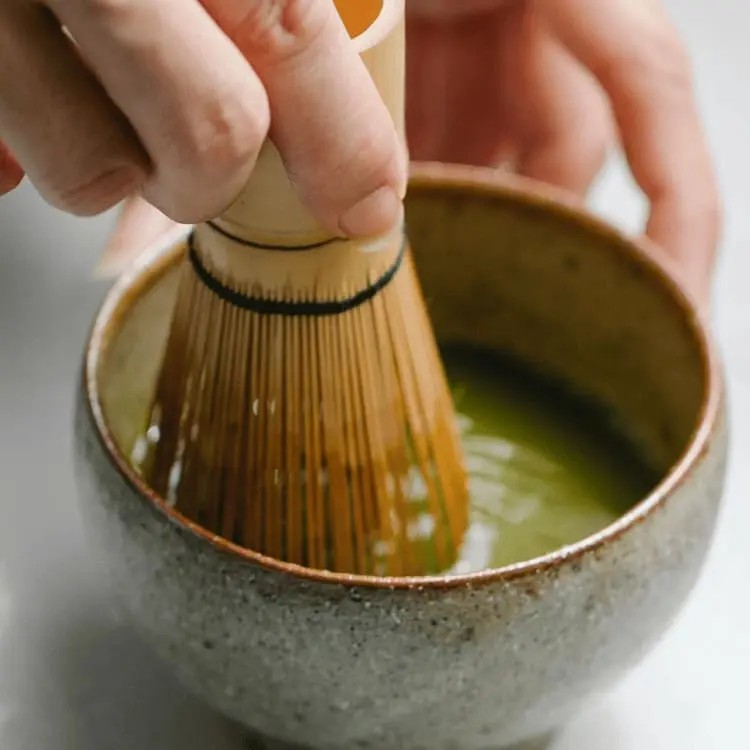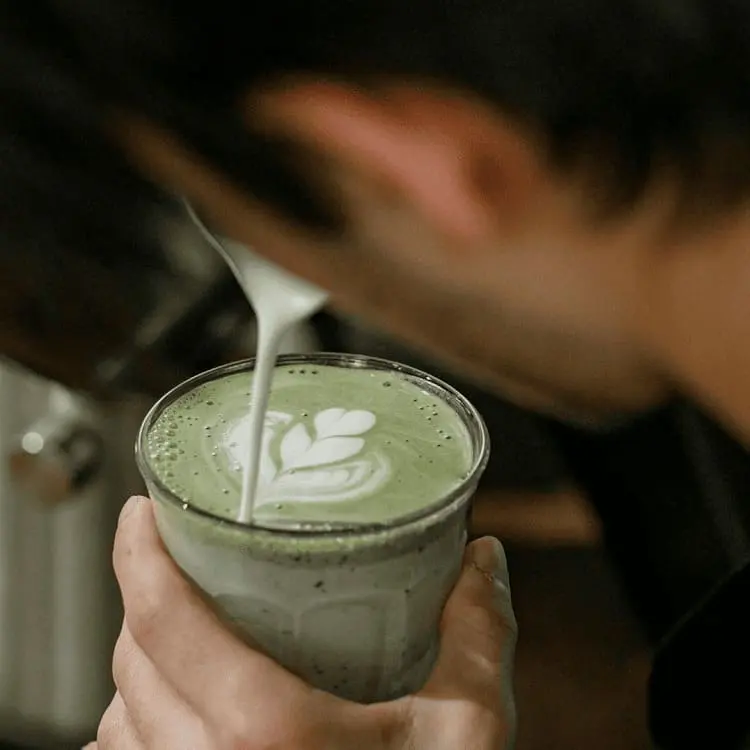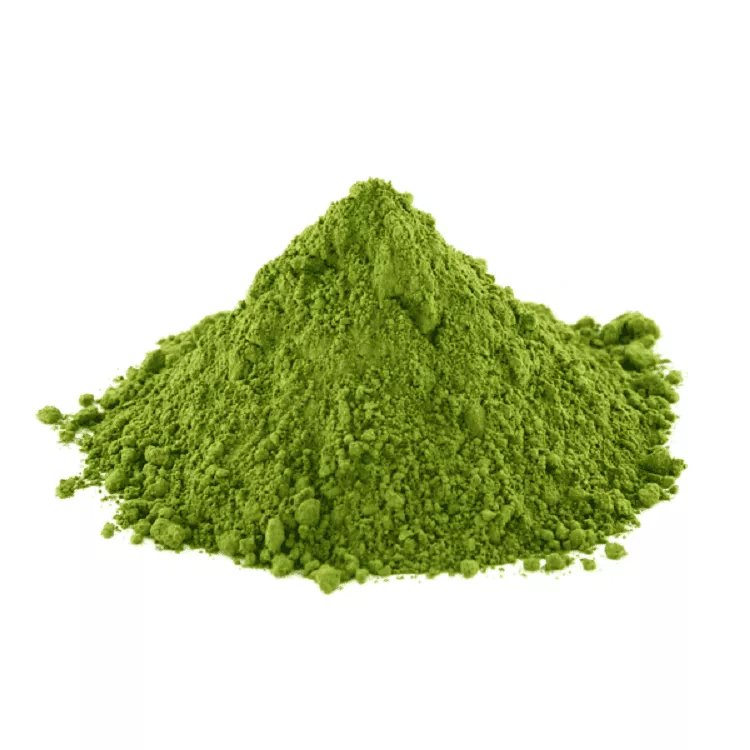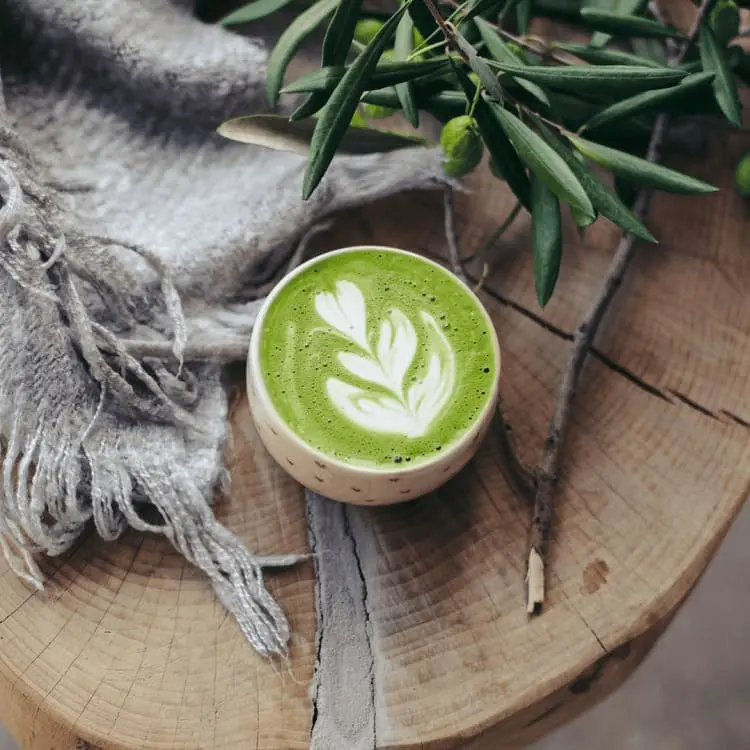What is a matcha latte?
Matcha is a Japanese powdered green tea with a long tradition. It is obtained from the young leaves of the Camellia Sinensis tea tree, which have been in the shade for the last few weeks before harvesting. The hand-picked leaves are steamed, dried, sometimes cooled, and then carefully ground into a powder with millstones. This process allows you to preserve all the beneficial properties of tea, because we consume not just a decoction, but the leaves themselves in ground form. Matcha is an integral part of Japanese tea ceremonies, and is a symbol of peace and harmony. This important meditative ritual takes place in silence and concentration. With the development of international trade and cultural exchanges, this tea has become available far beyond Japan.
It is used to make various drinks, the most popular of which is matcha latte.
Matcha latte is a drink that has become extremely popular around the world due to the combination of the unique taste of Japanese matcha tea and delicate milk foam. It emerged as a result of the globalization of tea culture, when Japanese green tea met the latte tradition popular in European cafes.
This drink combines several components: matcha powder, milk, and sweeteners.

Preparing a drink based on steeped tea leaves and milk
Matcha latte is a fairly simple tea to make even at home. It only requires a few ingredients and a little time.
For a basic matcha latte recipe you will need:
1-2 teaspoons of matcha powder.
200 ml of milk (milk can be plant-based or animal-based: cow’s, almond, soy, coconut, etc.).
Sweetener to taste (honey, sugar, agave syrup).
Hot water (about 50-60 ml).
Preparation:
Ideally, you need a special container (chawan/chawan), a bamboo whisk (chasen), a strainer, and a measuring spoon.
Pour 2 g of matcha powder into a cup and add hot water.
Traditionally, the dishes should be preheated with hot water and wiped dry. After that, the powder should be sieved through a sieve. Constantly stirring with a whisk, we get a homogeneous consistency. It is important that the water is 80℃. Boiling water can cause lumps.
Warming the dishes, as well as special dishes, is desirable, but not mandatory. At home, a cup and a regular spoon or mixer will suffice. The main task remains to dissolve the powder and obtain a homogeneous mixture.
In a separate saucepan, heat the milk to a temperature of 60-70°C. At home, you can use a French press or a foam mixer to obtain foam.
Sweetener is added to milk to soften the taste.
If you use animal milk that is sufficiently fatty and has a pronounced flavor, experts advise adding a double portion of sweetener for flavor balance.
Pour the milk into a cup with tea, stir until smooth. If desired, you can garnish the drink with an extra portion of foam, and add a little cinnamon or vanilla for flavor.

Matcha latte flavor palette
Its unusual taste and beneficial properties have quickly made matcha latte popular in the Western market. Unlike Eastern consumption traditions, in the dynamic modern world it has become simply a tasty and healthy drink that people love to drink in cafes or prepare at home.
The rich, bright taste of the drink is able to satisfy the most demanding gourmets. The combination of a strong bitter taste and creamy milky taste creates a unique balance of taste.
This drink has a special energy that invigorates and calms at the same time. That is why it is an ideal alternative to coffee.

There are many variations of the recipe.
You can easily adapt the drink to your own preferences.
Matcha latte with vanilla.
Add a few drops of vanilla extract to milk before heating to get a hint of your favorite sweet flavor.
Try adding honey.
Instead of sugar, you can use honey to add the natural sweetness and health benefits of honey.
Matcha latte with cinnamon.
Sprinkle the finished drink with cinnamon according to the basic recipe to give it a new flavor dimension.
Ice matcha latte.
Pour the finished drink according to the classic recipe into a tall glass and add ice.
White chocolate will create a velvety tactility to the drink.
Add melted white chocolate to the milk.
Matcha latte with spices.
Ginger, cardamom or cinnamon added to the drink will give a spicy warm vibe of an oriental fairy tale.
Strawberry iced matcha latte.
Grind the strawberries to a smooth puree consistency using a blender. Pour the fragrant strawberry puree into a tall glass.
Add ice and 100 – 150 ml of plant-based milk.
Rice, banana, and soy milks go best with strawberries.
And finally, add freshly brewed classic matcha tea.
Coconut mint matcha latte.
Baristas claim that it is with coconut milk that the drink acquires a delicate and balanced taste.
Heat the coconut milk over low heat, not boiling, add ½ tsp. cocoa powder, 1/8 tsp. peppermint extract, and 1 tbsp. maple syrup.
Without removing from the heat, add 2-3 g of matcha powder. Beat with an electric whisk for about 30 seconds until smooth.
Useful properties of matcha latte
This antioxidant-rich tea retains all the beneficial properties of matcha and helps maintain youth, improves the quality of skin and hair.
Studies have shown that regular consumption of matcha can help lower cholesterol levels and improve blood circulation. It promotes weight loss because it speeds up metabolism, regulates metabolism, and also calms the nervous system.
The leaves of the tea plant Camellia Sinensis contain L-theanine, which is an amino acid that helps you relax and reduce stress levels.
A wide range of vitamins helps strengthen the immune system.
Tea contains vitamins A, B1, B2, B6, C, E, P, K, calcium, fluorine, magnesium, zinc, iron, iodine, tannins and other beneficial compounds.
The drink provides calm, long-lasting energy without sudden spikes thanks to caffeine and L-theanine, which controls the slow release of energy.
The fashionable trend of choosing matcha latte instead of coffee or green tea is, first and foremost, a tendency to take care of your physical and emotional state.
Expert advice
Don’t be afraid to experiment!
For a milder taste, add vanilla syrup or coconut milk.
For a more intense aroma, special additives such as lavender or mint are used.
Add berries or fruits, such as raspberries or oranges, to the drink and you will get another unique recipe!
Matcha has a special, pronounced taste.
Most Japanese desserts that go well with matcha are difficult to make, require exclusive ingredients and special skills. You won’t find artificial colors, white sugar, preservatives, or stabilizers in the recipes. Instead, you’ll find herbs, chestnuts, sweet beans, and other unusual ingredients.
In Japan, it is customary to serve traditional Wagashi sweets with matcha drinks. The most popular desserts in this category are:
- Sweet rice cakes Moti
- Sweet rice cakes with Uiro filling
- Manju (rice, bean or buckwheat flour cakes)
- Ammitsu fruit-filled jelly cubes
- Buns with sweet paste (bean, chestnut, sesame) An-pan
- Jelly-like Warabimoti (made from fern flour)
Matcha latte is a delicious and healthy way to maintain your health and energy throughout the day.






